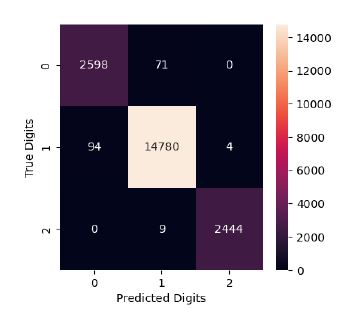Password Complexity Prediction Based on RoBERTa Algorithm
DOI:
https://doi.org/10.5281/zenodo.11180356Keywords:
password complexity, roberta, accuracyAbstract
Corresponding author email: In the digital age, password security is a top priority for protecting personal information. Machine learning techniques provide us with intelligent and efficient means to enhance password security. In this paper, we adopt RoBERTa algorithm and use the password complexity text dataset for password complexity prediction, and the confusion matrix and accuracy rate of the three classifications are derived through two model trainings. The confusion matrix shows that the vast majority of the classification results are accurate, and the accuracy of the two classifications is over 99.741% and 99.11%, respectively. This indicates that the model is able to effectively predict password complexity, provide users with accurate feedback, and prompt users to enhance password security in a timely manner. Through this study, we can better understand how to use machine learning technology to improve password security and protect personal private information from malicious intrusion. In our daily life, we should pay attention to the complexity of password settings and realise the importance of password security for personal information protection. We look forward to the launch of more similar studies in the future to further strengthen cybersecurity protection measures and work together to build a more secure and reliable digital environment.
Downloads
References
Mu, Pengyu, Wenhao Zhang, & Yuhong Mo. (2021). Research on spatio-temporal patterns of traffic operation index hotspots based on big data mining technology. Basic & Clinical Pharmacology & Toxicology, 128 (111), River ST, Hoboken, 07030-5774, NJ USA: Wiley.
Mo, Y., Qin, H., Dong, Y., Zhu, Z., & Li, Z. (2024). Large language model (llm) ai text generation detection based on transformer deep learning algorithm. International Journal of Engineering and Management Research, 14(2), 154-159.
Liu, B., Yu, L., Che, C., Lin, Q., Hu, H., & Zhao, X. (2023). Integration and performance analysis of artificial intelligence and computer vision based on deep learning algorithms. arXiv preprint arXiv:2312.12872.
Zhang, Jingyu, et al. (2024). Research on detection of floating objects in river and lake based on AI intelligent image recognition. arXiv preprint arXiv:2404.0688.
Xiang, Ao, et al. (2024). Research on splicingimage detection algorithms based on natural image statistical characteristics. arXiv preprint arXiv:2404.16296.
Dai, Shuying, et al. (2024). The cloud-based design of unmanned constant temperature food delivery trolley in the context of artificial intelligence. Journal of Computer Technology and Applied Mathematics, 11, 6-12.
Li, Zhenglin, et al. (2023). Stock market analysis and prediction using LSTM: A case study on technology stocks. Innovations in Applied Engineering and Technology, 1-6.
Li, Shaojie, Yuhong Mo, & Zhenglin Li. (2022). Automated pneumonia detection in chest x-ray images using deep learning model. Innovations in Applied Engineering and Technology, 1-6.
Mo, Y., Qin, H., Dong, Y., Zhu, Z., & Li, Z. (2024). Large language model (llm) ai text generation detection based on transformer deep learning algorithm. International Journal of Engineering and Management Research, 14(2), 154-159.
Mansouri, Mohamad, et al. (2023). Sok: Secure aggregation based on cryptographic schemes for federated learning. Proceedings on Privacy Enhancing Technologies.

Downloads
Published
How to Cite
Issue
Section
ARK
License
Copyright (c) 2024 Yuhong Mo, Shaojie Li, Yushan Dong, Ziyi Zhu, Zhenglin Li

This work is licensed under a Creative Commons Attribution 4.0 International License.
Research Articles in 'Applied Science and Engineering Journal for Advanced Research' are Open Access articles published under the Creative Commons CC BY License Creative Commons Attribution 4.0 International License http://creativecommons.org/licenses/by/4.0/. This license allows you to share – copy and redistribute the material in any medium or format. Adapt – remix, transform, and build upon the material for any purpose, even commercially.










